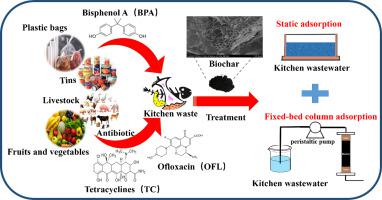Science of the Total Environment ( IF 9.8 ) Pub Date : 2021-09-08 , DOI: 10.1016/j.scitotenv.2021.150158 Ye Tang 1 , Ye Li 1 , Lu Zhan 2 , Dong Wu 1 , Suhua Zhang 3 , Ruirui Pang 1 , Bing Xie 4

|
Using current wastewater treatment technologies, it can be challenging to remove the emerging contaminants (ECs) present in kitchen wastewater (KW) of complex compositions and high organic content. In this study, biochar, derived from straw, was modified as an adsorbent to remove ECs such as bisphenol A (BPA), tetracycline (TC) and ofloxacin (OFL) from a complex KW system. An alkali-modified biochar, having larger specific surface areas and stronger hydrophobicity, was found to exhibit a higher adsorption capacity, with more than 95% of the target ECs being removed. Indeed, in a static operation mode, the alkali-modified biochar had maximum adsorption capacities of 71.43, 101.01 and 54.05 mg/g for BPA, TC, and OFL, respectively. The adsorption kinetics and isotherms models indicated that the adsorption process was controlled by chemisorption, as well as the monolayer adsorption of contaminants onto the external and internal surfaces of the alkali-modified biochar. The adsorption of TC and OFL was significantly affected by the initial pH values of KW. However, the presence of different environmental factors (COD, NH4+ and PO43−) had little effects on the adsorption of the contaminants. The alkali-modified biochar was further tested in a fixed-bed column where the maximum dynamic adsorption capacities for BPA and OFL were 55 and 45 mg/g, representing about 75% and 83% of the static saturated adsorption capacities. These findings can be of major significance for the application of alkali-modified biochar in the removal of ECs from complex KW systems.
中文翻译:

碱改性生物炭去除厨房废水中新出现的污染物(双酚 A 和抗生素)
使用当前的废水处理技术,去除组成复杂且有机物含量高的厨房废水 (KW) 中存在的新兴污染物 (EC) 可能具有挑战性。在这项研究中,来自秸秆的生物炭被修饰为吸附剂,以从复杂的 KW 系统中去除 ECs,如双酚 A (BPA)、四环素 (TC) 和氧氟沙星 (OFL)。发现具有更大比表面积和更强疏水性的碱改性生物炭表现出更高的吸附能力,超过 95% 的目标 EC 被去除。事实上,在静态操作模式下,碱改性生物炭对 BPA、TC 和 OFL 的最大吸附容量分别为 71.43、101.01 和 54.05 mg/g。吸附动力学和等温线模型表明吸附过程受化学吸附控制,以及污染物在碱改性生物炭的外表面和内表面上的单层吸附。TC 和 OFL 的吸附受 KW 初始 pH 值的显着影响。然而,不同环境因素(COD、NH4 +和PO 4 3- )对污染物的吸附作用很小。碱改性生物炭在固定床柱中进一步测试,其中 BPA 和 OFL 的最大动态吸附容量分别为 55 和 45 mg/g,分别代表静态饱和吸附容量的 75% 和 83%。这些发现对于碱改性生物炭在从复杂的 KW 系统中去除 ECs 中的应用具有重要意义。



























 京公网安备 11010802027423号
京公网安备 11010802027423号